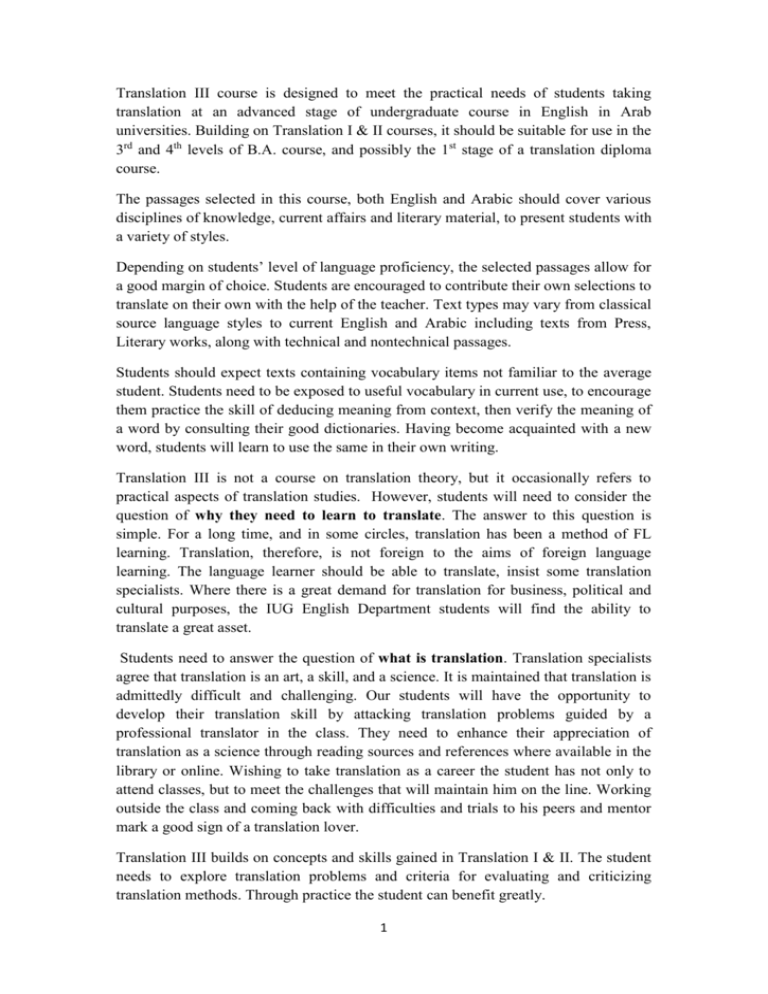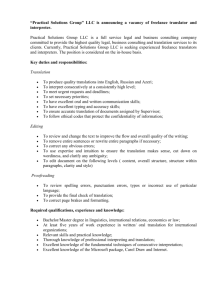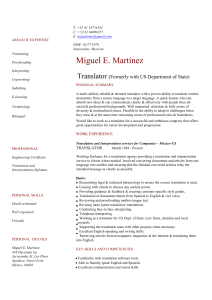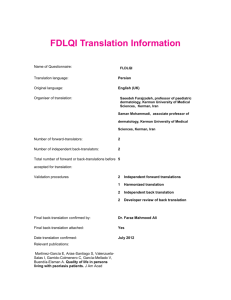Translation III course is designed to meet the practical needs of
advertisement

Translation III course is designed to meet the practical needs of students taking translation at an advanced stage of undergraduate course in English in Arab universities. Building on Translation I & II courses, it should be suitable for use in the 3rd and 4th levels of B.A. course, and possibly the 1st stage of a translation diploma course. The passages selected in this course, both English and Arabic should cover various disciplines of knowledge, current affairs and literary material, to present students with a variety of styles. Depending on students’ level of language proficiency, the selected passages allow for a good margin of choice. Students are encouraged to contribute their own selections to translate on their own with the help of the teacher. Text types may vary from classical source language styles to current English and Arabic including texts from Press, Literary works, along with technical and nontechnical passages. Students should expect texts containing vocabulary items not familiar to the average student. Students need to be exposed to useful vocabulary in current use, to encourage them practice the skill of deducing meaning from context, then verify the meaning of a word by consulting their good dictionaries. Having become acquainted with a new word, students will learn to use the same in their own writing. Translation III is not a course on translation theory, but it occasionally refers to practical aspects of translation studies. However, students will need to consider the question of why they need to learn to translate. The answer to this question is simple. For a long time, and in some circles, translation has been a method of FL learning. Translation, therefore, is not foreign to the aims of foreign language learning. The language learner should be able to translate, insist some translation specialists. Where there is a great demand for translation for business, political and cultural purposes, the IUG English Department students will find the ability to translate a great asset. Students need to answer the question of what is translation. Translation specialists agree that translation is an art, a skill, and a science. It is maintained that translation is admittedly difficult and challenging. Our students will have the opportunity to develop their translation skill by attacking translation problems guided by a professional translator in the class. They need to enhance their appreciation of translation as a science through reading sources and references where available in the library or online. Wishing to take translation as a career the student has not only to attend classes, but to meet the challenges that will maintain him on the line. Working outside the class and coming back with difficulties and trials to his peers and mentor mark a good sign of a translation lover. Translation III builds on concepts and skills gained in Translation I & II. The student needs to explore translation problems and criteria for evaluating and criticizing translation methods. Through practice the student can benefit greatly. 1 Translation III capitalizes on basic concepts and skills fostered in the previous levels of study. The students need to revise their previous work and come armed with types of translation. They have learnt, for instance, to differentiate between semantic translation and communicative translation. In the first, the translator “attempts within the bare syntactic and semantic constraints of the target language, to produce the precise contextual meaning of the author.”1 In communicative translation, the translator “attempts to produce the same effect on the target reader as produced by the original on the source language reader.”2 The translation student here comes with an appreciation of such basic concepts that narrow the traditional distinction between “free” and “literal” translation. He still understands that the translator must turn his attention both to the ideas and the words and then to the arrangement (syntax and stress) before he operates his techniques and undertakes his middle-way decisions. The translation student has learnt in class that translation types overlap in some cases. Initiated in the procedures of translation, students know that semantic translation is generally the aim in initial training. In this case, conveying the meaning from a SL into a TL. In saying this, the student understands the fact that sentence structure or syntax is one way of conveying meaning. In literary texts in particular, syntax, word order, rhythm and even sound, all have semantic values. Thus in attempting to convey meaning as accurately and as fully as possible, the translation trainee has to make choices and take middle-way decisions, i.e. compromises. The maxim that “the translation should be as literal as possible and as free as is necessary,” can be taken as a guide when he makes a choice. The students have learnt the basic translation process in the previous levels, namely comprehension and formulation. There is no translation without comprehension of SL and one cannot create a natural TL text without a process of formulating the SL message. Equipped with a degree of a competence in the two languages and cultures, the translator is relatively able to operate across the linguistic and cultural barriers at hand. Knowledge of SL is needed not only for comprehension of a text, but also quite often for its analysis and interpretation. Knowledge of TL is needed for formulation of the message, transferring it to TL in an accurate and natural manner. A good translation, insists translation principles, should not sound like a translation but like an original. In the absence of such knowledge, translating verbatim with the help of a dictionary can be absurd and terrible. Translation III is a good opportunity to freely revise the ONLINE Document “Translation Principles and Procedures” found on the Teacher’s page. 1 2 Newmark, P, (1981) Approaches to Translation, Oxford, Pergamon Press, p. 22. Ibid. 2 As an art, translation requires the qualities of intelligence, flexibility, resourcefulness and sensitivity in the use of language. Patience and perseverance are not less useful for the translator trainee. The Translation Process Practical Aspects The transfer of meaning from SL to TL requires clarity of Unit of Translation Concept. The unit of translation can be the word, the sentence or the paragraph. The word gains meaning from the context, and in the neighbourhood of other words. One needs to read of the whole paragraph of SLT for translation, sometimes the whole text, before attempting the translation of the units of which it is composed. Full comprehension of the meaning of a text is crucial to the undertaking and a safeguard against misunderstanding particular words, which may have several meanings, and can thus lead to grave mistakes in the transfer to TL. The translator trainee would do well to keep another maxim in mind. “The unit of translation is always as short as possible, and as long as necessary.” The Concept of Equivalence In translating lexical items, one naturally looks for the equivalent in TL. Resort to a near equivalent if an equivalent is not available, suggest translation principles. Do not improvise where an equivalent is not available, insist translation principles. This is most important in the case of technical terms, or standardized language. Terms of art, formulae, the set language of institutions, procedures … must be translated by the equivalent TL term, if one exists. Ignorance of such terms may lead to very ridiculous consequences. Students need to initiate their own glossary book in the area of their interest. They also need to maintain a lexicon of current and recurring terms acquired in the course of study and research. It is sad to infrequently wrongly transfer a host of well-known words by our students due to a tendency of carelessness. The translator needs to have a good memory a long with good references to cope with the challenges of translating. Though the lexical side of translation seems to be the easiest aspect to handle, students have to allow it a great deal of attention. Even in the case of fairly good published translations, one comes across the lapse which in an official statement can have disastrous results, and in the work of a significant literature completely ruins the meaning of a text. This creates the need to discuss certain instances of technical and non-technical terms in this course of study. Grammar and Syntax Grammar and syntax are the two next aspects for the trainee to consider, in relation to both comprehension and formulation. Every language has its own grammar, syntax and idioms. Interlingual translation requires students’ awareness of the basic differences, grammatical and syntactical, between a pair of languages, bearing in mind the distance between Arabic and English. The importance of contrastive 3 grammar and syntax study becomes clear as it is useful in the translation process. This indicates the need that the translation courses should come after the linguistics courses in the course of study. Students have been trained to pay special attention to such grammatical features as word order, subject-verb agreement, tenses, prepositions in translation I & II and in contrastive grammar and syntax. For instance, Arabic sentence begins with the verb, unless it is marked with rhetorical purposes. Verb-subject agreement Arabic takes count of the dual and the feminine when English is restricted to the singular and plural and the masculine. Punctuation and capital annotation have grammatical functions to be minded in translating from English into Arabic. Structural and syntactical problems and advice related to differences between Arabic and English styles are useful points for Arab translator trainees. Such problems highlight necessary transfers and transformational possibilities are useful in this respect. For instance, students have trained to replace the passive in English by the active in Arabic, to place the relative pronoun immediately after the noun it is related to or to follow English grammatical rules for placing adverbs. These were points that were stressed at the earlier stages in the hope that they would become second nature in our students. Translation III as an advanced course highlights matters of tone and emphasis as they require special attention at this level. Simple devices as italics, or capitals which do not exist in Arabic, need consideration when they occur in a text. Students will need to mind differences between natural (unmarked) and emphatic (marked) constructions. This is often indicated by word order, nominalization, forwarding and italics. These features need to be conveyed in TL. Lacking italics, Arabic version words may simply be underlined. Alternatively, to convey emphasis in Arabic, one may use emphatic words, add a word or change the structure of the sentence. Tone, the author’s attitude towards his material, is generally conveyed through syntax and by means of emphasis and other stylistic devices. This is particularly important in literary translation. The translator “has to have a sharp eye for oppositions and emphasis … in the original, and if it is a non-literary text, he has to know how to accentuate in his own version. He has to distinguish synonyms used to give additional or complimentary information from synonyms used simply to refer to a previously mentioned object or concept. In literary translation … his hardest task is to catch the pace of the original.”3 In Translation Course I (Thinking Arabic Translation), students are prepared to make adjustments in TLT. However, there are limits to such adjustments. This is introduced in the concepts of free-bound and free-loose translation, where the latter can be 3 Newmark, p. 17. 4 considered translation at all. Neither unnecessary additions or expansions nor omissions can be in any sense regarded as adjustments. The first commandment of translation is: be accurate and precise. The translator cannot have the liberty to make needless disturbance in SLT if he is worth his name. In Thinking Arabic Translation, students have been introduced to such concepts as translation by addition (Ch. 2.2.1.2) and translation by omission (Ch. 2.2.1.1). The translator, if necessary, adds to/omits from TT something which does not occur/occurs in ST. both concepts refer to any feature of incomplete replication of ST in TL; translation loss involves omission of ST feature not available in TL; where TL has features not available in ST, the addition of these features counts as translation loss (Ch. 2.2.1). Translation II & III students may refer to translation basic concepts and procedures in Thinking Arabic Translation and other References/Sources to be able to cope with the tasks offered/encountered in this course. Teachers of translation to Arab students need not assume that their students are capable of thinking in English in the way native speakers do, or that their Arabic will take a leave in the four-year undergraduate degree period. The reality is that Arabic continues to be the language they use both in speech and in thinking. Writing teachers in the Department are the ones who suffer most in the initial English compositions of their students. Our students normally converse, read and dream in Arabic. When they use English for general purposes, Arabic continues to be their ‘language of reference’ and they inevitably translate from the same. Just how good their English is, often is a matter of how well they can translate, especially as most of the English words in their possession have Arabic equivalents which are impossible to dislodge. Some of these are good enough; but many are quite inaccurate. Problems of lexical ‘interference’ do not suffer from neglect in linguistic studies; but interest seems to focus on structural rather than lexical aspects. Both problems are important and lexical problems cannot be minimized. Students have learnt to equate individual English words with Arabic ‘synonyms’. This has been a major fault in the teaching of the foreign language because it comprises a degree of falsification. Recognizing one Arabic word for each English word makes the student unable to see the right meaning of the word in a phrase comprising it in a different morphological form or syntactical structure. Consider lexical items like: conquer; chair; control; power; authority, etc. The fact that such words appear easy because of familiarity to the student causes most troubles. A student would not consider consulting a dictionary for a familiar word. Translation demands the student to make a good use of his tools including different types of dictionaries. Translation can improve a foreign learner’s linguistic skills by refining the meaning of words acquired through his native language. A more important function of translation is to make the student conscious of the syntactic differences between his pair of 5 languages. Consequently, the student’s awareness of SL and TL syntaxes alongside the intricacies of Arabic syntax which cannot often be taken for granted. Paying more attention to Arabic syntax and sentence-sequences, the student could initially learn, for instance, that Arabic strongly opposes the use of many qualifications, ‘comparatives’, and medial clauses. Standard Arabic style tends to favour the straightforward, clear and direct expression. This perhaps has to do with the Arab mind rather than with the Arabic language. The Arab reader prefers a statement that is not obscure or overloaded with qualifications and interruptions. At a later stage, the student will have to learn how to convey the tone of the English text by attempting syntactical tricks comparable to the original; such a skill crystalizes after he trains on the mere transmission of meaning directly, even at the expense of tone. 6









